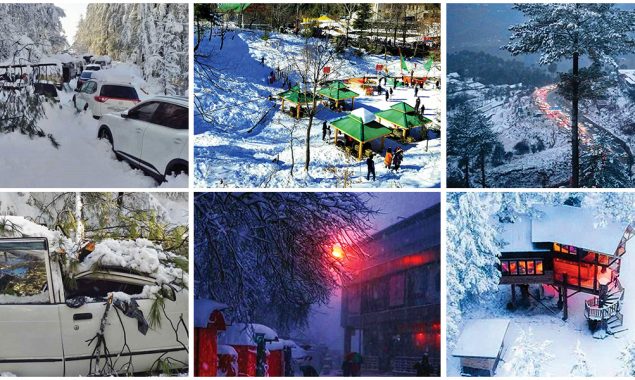Synopsis
Locals urge need for inclusive decision-making for the hill station

Photos: Mian Khursheed & Sajid Rahim
MURREE: The climate crisis, and the many problems it brings with it to the urban areas, has started to show its adverse effects to the environmental assets of the resort town of Murree.
After the tragic January 7 incident, tourists were once again stranded in the most sought-after tourist point over the past week reportedly due to the increased slipperiness at the jammed roads.
The rescue teams reached the spot to manage the traffic jams; but such exhibitory efforts do not address the underlying issues that the people of the region have to face.
Muhammad Ajmal Nawaz, who runs a tour operator and travel company in the Islamabad-Murree region, told Bol News that he has never seen such an extreme snowstorm in Murree and nearby areas ever before.
“Each year, we experience severe snowstorms in which cars get trapped but the severity we saw in this year’s icy-cold temperatures throughout December and January was unprecedented. As a tour guide, it was a very embarrassing situation for us.”
He added that the snowfall at this 20 kilometres to 30kms road belt could have been systematically removed using snow excavators. “But our local administration failed to even prepare for that. When we have over 100,000 tourists coming in, this is the least that could have been done to serve them.”
Furthermore, it is evident now that the government has no plans to combat the climate crisis, he regretted.
“The tourists who come here knowing of the situation are always prepared for their vacation, but since they were trapped for a prolonged period earlier this month, they ran out of supplies and could not move out of their cars,” he observed.
The tour operator has stressed that more research is needed in such tourism spots to figure out what exactly happens annually during the periods of extreme weather. “Do we really want to leave local and international tourists with this impression that we cannot even arrange excavators and cranes for their safety?”
Infrastructure issues
Speaking about the infrastructure in Murree, Nawaz has asserted that decent roads and tourist spots are hard to find. “There is only one road belt from Murree to Bhurban to Nathia Gali and there is no alternative for the thousands of commuters that pass from here.”
There are a few small hotels and motels here but that is pretty much it; no proper parking spaces or recreation areas for people to spend time, he explained. “All the government departments really had to do was to study the pre-pandemic and present trends in the data-sets to predict what could have been the situation.”
This would have stopped the glut of tourist influx and the subsequent traffic jams leading to the hill station, he claimed.
“Even the tour operators do not have much say in when people can or cannot take vacations. They simply cancel or postpone their events if they anticipate extreme weather conditions in the region.”
I did not witness any meaningful groundwork done to compensate the suffering visitors, he highlighted. The hotel owners were busy running their money mills and there was no appropriate humanitarian effort made as was claimed on social media platforms,” Nawaz elaborated.
The climate crisis in Pakistan was clearly the main factor responsible for what happened in Murree, he argued. “Even in the coldest regions, we are experiencing scorching heat during the summers and this was not usual when we were growing up. The Himalayan-Alpine zone from Murree to Kashmir has such unbearable weather conditions now. And this also means that the hill station is not the only place we should be concerned about,” warned the tour operator.
When our people take vacations, they only see Murree, Kashmir and Gilgit-Baltistan as tourist spots, he expressed. “These are our lands and people live here like they do in the cosmopolitan cities. We cannot be defined by tourism and cultural attractions only.”
First-hand accounts
Sajid Abbasi, who is a hotel owner in the hill station, said that there were families including infants that got stuck in the deep snow, and he personally had to step out in the cold to receive them as well as to help them in collecting their belongings back to the hotel.
“We had to walk for up to an hour for a distance that is usually covered in around five to 10 minutes only. During this walk, the snow often reached higher than our knees and we had to take long breaks to rest and breathe properly.”
He elaborated, “While all we did was to provide basic humanitarian support to our guests, they were so overstressed and terrified that many of them came up to us in praise and said that they felt they got a second chance at life due to the extreme weather condition outdoors. We offered them meals thrice a day and also made arrangement for medicines when we could.”
Aqib Osama, a local tourist who was rescued from the Rati Gali area near the Usmania Mosque, stated that he was trapped with his family during the tour but the locals reached out and brought him to a safe hotel.
“I was humbled by the humanitarian support of the people who offered me to stay over at their homes during the crisis. I am one of the lucky ones who was comforted during the situation.”
My family was secured during our visit and that was all I really expected and wanted, he added. “Sadly, others had to do for me what was basically expected from the authorities concerned.”
Abdul Basit, a resident of Murree stated “During this painful period, someone would call every day. The locals were generous to send boxes of fruit to the stranded people here. As many as 1,500 stranded visitors were looked after in the area and they were able to see the [generosity] of the local residents here.”
The New Murree Development Authority (NMDA) Act, 2004 gave legislative cover to an authority of the same name. However, in 2008, it was dissolved by the Punjab government due to the concerns that the project, entailing massive construction activity at the time, would cause irreparable damage to Murree’s natural environment.
Commenting over this matter, Advocate Ghulam Qasim Bhatti said that the NMDA Act, 2004 has shaped the development of the hill station.
It has been envisaged in the preamble of the Act, 2004 that ‘in the public interest to establish an authority for planning, development and management of a new township near Murree and to make provisions for matters connected therewith and ancillary thereto,’ the first and foremost function of the authority is to work for planning development and management of the area called Murree, he stated.
It has been more clearly mentioned in section 7(1) of the Act, 2004 that the authority may exercise such powers and take such measures as may be necessary for the development of Murree, he also said. “The Murree Development Authority created under the Act, 2004, has also got the powers to prepare and approve the master plan and phased master programme for the development and urban planning etc.”
Regarding the provisions related to tourism, the advocate added, “The authority created under the Act, 2004, must be consisting of as many as 11 ex-officio members in which the Chief Minister and Secretary Tourism and Resort Development Department and five non-government members which will be appointed by the provisional government.”
But interestingly, there is no provision in the Act, 2004 for the development of tourism in the area of Murree and for the protection of tourists in Murree and nearby areas, he revealed. “The Act, 2004 is silent about the protection of tourists in Murree.”
The advocate clarified that there are no other laws that affect the resort town. He asserted that there is a need for a law on the climate crisis to protect Murree’s residents. The Islamabad deputy commissioner as well as the Islamabad additional deputy commissioner were not available to comment over the climate crisis in the region.
Despite the crises facing the resort town, it is conceived to be the ideal tourist destination for many local visitors.
However, before any major decision is made about how the hill station should be run, it is important to include its indigenous residents in any decision-making process. Environment protection groups as well as civil society organisations should also be taken on board as they rightly raised concerns of the problems faced by the stakeholders.
Moreover, the well-considered view of the urban planning experts should be prioritised as any tourist resort project in the future should have an imprint that supports Murree’s ecological system.
Read More News On
Catch all the Pakistan News, Breaking News Event and Latest News Updates on The BOL News
Download The BOL News App to get the Daily News Update & Follow us on Google News.




